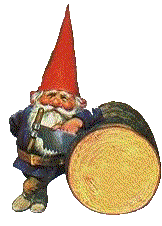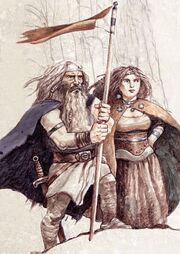
The dwarves of folklore are small bearded old men with ruddy cheeks and a lumberjack appearance, in the fantasy world they are instead a small and proud race of warriors with a prodigious strength.
The world of fairy tales unites dwarfs and elves, giving the elves a more joking spirit and the dwarves a fixation for gem mines.
In the fairy tales dwarf and gnome are equivalent terms.

 Spirits of the earth and the subsoil, the dwarves are called gnomes in 1500 by the alchemist Paracelsus (in Liber de nymphis, sylphis, pygmaeis et salamandris et de caeteris spiritibus)which might have coined the term “gnomus” to describe these little elementary, who very much share with the dwarves of Norse mythology.
Spirits of the earth and the subsoil, the dwarves are called gnomes in 1500 by the alchemist Paracelsus (in Liber de nymphis, sylphis, pygmaeis et salamandris et de caeteris spiritibus)which might have coined the term “gnomus” to describe these little elementary, who very much share with the dwarves of Norse mythology.
They are massive, compact and with great strength, they are the ones that set the mineral element of the earth in motion to nourish the roots of plants.
Rudolf Steiner tells us that when in autumn the plant wilts, and disperses all its physical matter in the environment, the ideal shape of the plant penetrates into the soil. The gnomes perceive the shapes of this ideal plant and keep them in themselves. When the seeds also penetrate the ground, the gnomes, during the winter, make this feminine structure of the ideal plant meet the male seeds. From this meeting, from this embrace of the feminine and the masculine under the warm, welcoming underground world, the fertilization of a new plant takes place that will sprout up to the surface in spring, to give us life, beauty, refreshment. (translated from qui)
DVERGAR
In the Norse and Germanic mythology dvergar is the lineage of the dwarves born from the petrified flesh of the giant Ymir. The Newly borns seem like worms and the gods give them human form, consciousness and intelligence.
In the Edda in prose four dwarfs are placed to hold the firmament one for each cardinal point, the others live in Svartálfaheimr, (the world of black elves) or underground. The sagas never describe them to us and so we see them with the eyes of the Middle Ages, rough, deformed and of small stature (as well as with demonic traits).
Guardians of mines and keepers of jewelry and gold coins, jewels and precious stones are partakers of the secrets of plants and minerals, they are the guardians of primordial fire and know the art of forging metals to shape the weapons of gods, the most famous magic swords are their work. They are also the guardians of the treasures deposited in the burial mounds and more generally of the hidden treasures underground and their wisdom is proverbial ; the dwarves are experts in spells and runes.
In Brittany the dwarves are called korrigans and from this Breton tradition comes this lullaby.
Bin, Ban, Korriganan – Jean-Luc Lenoir in “Old Celtic & Nordic Ballads”
Bin, Ban Korriganan pelec’h e moc’h, epad ar goan? -Narz an toulle, barz an douar, da gortoz an amzer clouar |
English translation “Bin, ban Dwarf where are you during winter? -in a little hole, in the ground, waiting for the warm weather” |
French translation
Bin, Ban Naine
où es-tu pendant l’hiver?
Dans un petit trou, dans la terre,
pour attendre le temps tiède”
italian translation
“Bin Ban, nano,
dove sei in inverno?”
” In una piccola tana sotto terra,
ad attendere il bel tempo”
DWARVES BY TOLKIEN
Now after the saga released on the big screen, the whole world knows the story of the Dwarves of Durin and the Hobbits, so I dwell only on the song “I see fire” by Ed Sheeran in the credits of the film “The Desolation of Smaug” of the 2013. According to the indications of the director Sheeran tells the last moments of the film with the song.

I Oh, misty eye (1) of the Mountain below Keep careful watch of my brothers’ souls (2) And should the sky be filled with fire and smoke Keep watching over Durin’s son II If this is to end in fire Then we should all burn together Watch the flames climb higher into the night Calling our father hold stand by (3) and we will watch the flames burn on and on (4) the mountain side hey III And if we should die tonight Then we should all die together Raise a glass of wine for the last time Calling our father hold Prepare as we will watch the flames burn on and on the mountain side Desolation comes upon the sky CHORUS Now I see fire, inside the mountain I see fire, burning the trees And I see fire, hollowing souls (5) And I see fire, blooding the breeze And I hope that you’ll remember me IV Oh, should my people fall Then surely I’ll do the same Confined in mountain halls We got too close to the flame Calling our father hold fast and we will watch the flames burn on and on the mountain side Desolation comes upon the sky V And if the night is burning I will cover my eyes For if the dark returns then My brothers will die And as the sky’s falling down It crashed into this lonely town (7) And with that shadow (8) upon the ground I hear my people screaming out FINAL CHORUS I see fire, oh you know I saw a city burning (fire) And I see fire, feel the heat upon my skin (fire) And I see fire (fire) And I see fire (burn on and on and mountains side) |
Who is the subject singing the song? A dwarf of the mountain perhaps the same Thorin or is a man from the city of the Lake, perhaps Bard? What is the city that is burning or that is about to burn by Smaug? In my opinion, two cities merge in the song, the first is Dale the city of men built in front of the entrance to Erebor, once a large and thriving commercial center, abandoned by the survivors of the dragon’s fury. They moved to Esagorth, built on stilts in the middle of the lake. Almost 200 years later the dragon awakened by Bilbo is about to devastate Esgaroth so in the song the last stanza could be a flash-back of Thorin (the dwarves according to Tolkien could live up to 500-800 years) 1) King Thorin 2) fate of the companions 3) or “Calling out for the rope, sent by” = following the guide sent to us. referring to the myth of Arianna’s thread and the labyrinth (see) the verse would link the story with Bilbo the burglar. The phrase is sometimes simply written as “Calling our father oh” = I invoke our father, who could be the mystic eye at the opening of the song, a sort of a tutelary deity; my reading is inclined to claim the legacy of Thorin and his bloodline “Calling our father hold” 4) “Watch the flames burn auburn over” = we will see the copper-colored flames burning; but in other versions it is more simply written “the flames burn on and on” 5) fire consumes not only the physical body but also dissolves the memory of a people, its essence 6) here begins the flash-back of Thorin : in the initial verse Thorin’s eyes are open and veiled by the tears in the final one they are closed 7) the present with Smaug flying over the city in the middle of the lake overlaps the past with the destruction of Dale and Erebor 8) the body of the dragon a giant shadow on the ground, the darkness that returns and still brings desolation |
SOURCES
http://chrsouchon.free.fr/korredf.htm
http://bifrost.it/GERMANI/2.Cosmogonia/04-Nani.html
http://www.maison-des-legendes.com/orig_korrigans.html
http://www.centrostudilaruna.it/il-piccolo-popolo-degli-elementi.html
https://unicornos.com/2016/01/26/gli-gnomi-coboldi-pigmei-nani/
https://wunderkammern.wordpress.com/2010/08/26/gli-gnomi/
